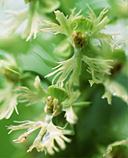Platanthera lacera (Michx.) G. Don in Sweet
Ragged fringed-orchid
The specific epithet lacera is the Latin meaning "torn,"
referring to the erose or fringed margin of the labellum of this species.


The following is a photo of a peloric
specimen of P. lacera that I found growing in a powerline right-of-way
in Pennsylvania in July 1994. The two upper petals have become labella,
complete with spurs (and these were full of nectar!). Floral mutations (pelory)
are not uncommon in cultivated orchids, and apparently also in wild orchids.
Perhaps this is a consequence of the extraordinary floral lability orchids;
a trait which has apparently driven their spectacular radiation in floral
syndromes and associated pollination biology.

DESCRIPTION: Plant
glabrous, arising from a cluster of fleshy, thickened roots, 20-70 cm tall.
Leaves 2-5, lanceolate to elliptical, gradually reduced to linear-lanceolate
bracts higher up on the stem, 5-19 cm long and 2-5 cm wide, keeled. Inflorescence
a loose or dense raceme, 10-60 flowered; flowers green, greenish-white,
or yellowish-white, +/- fragrant, each flower subtended by a lance-linear,
acuminate bract. Sepals ovate-elliptic to ovate, 4-6 mm long and
3-5 mm wide, colored as flowers; dorsal sepal loosely connivent with petals,
lateral sepals concave, reflexed. Petals linear-oblong to linear,
3-7 mm long and 1-2 mm wide, the margin finely lacerate or toothed, loosely
appressed to the dorsal sepal and colored as the sepals. Labellum
tripartite and fringed (the divisions of the lateral segments typically
reaching more than halfway to the base of the labellum), shallowly clawed,
each segment of labellum fan-shaped; 7-15 mm long and 7-15 mm wide, colored
as flowers but the claw typically whitish; base of labellum with a +/- clubbed
nectar spur projecting behind, 0.8-2.3 cm long.
SIMILAR SPECIES: Platanthera lacera is most likely to be confused
with P. leucophaea or the rare albino
P. psycodes. P. lacera can be
separated from P. leucophaea by the
relative length of the spur: the spur is much longer than the ovary in P.
leucophaea, and shorter than or equal to the ovary in P. lacera.
The rare albino specimen of P. psycodes
can be separated by the shape of the labellum. The labellum of P. lacera
is deeply lacerate (usually greater than half the length of the labellum),
and the three divisions are fairly narrow; in P.
psycodes the labellum is shallowly lacerate (usually less than half
the length of the labellum) and the three divisions are broad.
HABITAT: Platanthera lacera is found in a variety of open, acidic-soiled
habitats. Typical habitats include open Sphagnum bogs, and wet (or
rarely dry) acidic meadows or roadside ditches.
FLOWERING DATES: July 1-August 1.
POLLINATION: Pollinated by noctuid moths and hawkmoths (Duckett
1983). Warren Stoutamire (personal communication) told me that he collected
Hemaris thysbe in the Upper Peninsula of Michigan with pollinia of
both P. lacera and P. psycodes on its proboscis. Nearby were
hybrid P. X andrewsii; the moth is most likely the agent responsible
for the hybridization.
DISCUSSION: Platanthera lacera occasionally hybridizes with
P. psycodes to form the hybrid P. X andrewsii, which
has been collected in Wisconsin several times (Catling
1995). The hybrids tend to be intermediate in many characters, although
in general appearance they tend to look more like P. lacera.
WI DISTRIBUTION:  U.S. DISTRIBUTION:
U.S. DISTRIBUTION:
Go directly to Wisconsin herbarium records.
Return
to the main LIST of the Orchids of Wisconsin.
Return to the main KEY to the Orchids of
Wisconsin.



 U.S. DISTRIBUTION:
U.S. DISTRIBUTION: